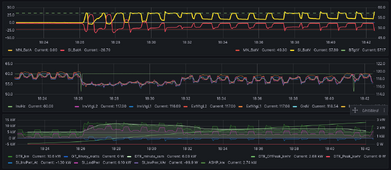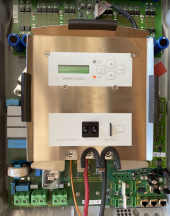I don't have any SMA PV inverters.
The relay is 3PST. If it's running with some significant load through the relay, an IR camera on each of the internal wires of the relay might show if it's using 2 or 3 of the contacts. My cheapo IR toy is not good enough resolution to see.
Maybe I'll turn down how much current comes through the relay. Not sure if that would help relay life or not.
Does it ever disconnect from the grid, if passing too much through the relay (relative to GdCurNom setting), that could result in more relay cycles. Will it disconnect if the 56A limit is getting abused, I don't see any mention? More cycles, more opportunity for welding the contacts, and more mechanical wear on the relay. I have been running InvChrgCurMax = 37A, GdCurNom = 38A. Maybe I should put them at about 30A instead. I already do see frequent warning messages W377 W378 max current exceeded. I'm not sure there's any consequence to that warning message.
The largest house load is the induction range, which is always fed from the inverters. Other loads in the house are relatively small in comparison. An EV charger and a heatpump are fed directly from the grid panel, not going through the inverters. Except when there is excess solar, those can be run from the AC coupled solar behind the inverters, but the power is not passing through the inverters unless they are making up the difference. The range can use 16-20a in typical use, I guess. Should I leave some headroom for loads, put the InvChgCurMax say 20A less than the GdCurNom, but then battery charging from grid will always be slower. That could be ok, the battery still gets pretty heavy charging on full sun days, and separate lithium batteries do most of the energy throughput, the SI lead batteries mostly float unless handling transients.
What do the SIs do when the GdCurNom is exceeded? It would reduce the battery charging, I guess, that's all the inverter can do. No, I guess I forgot, that's a feature the manual describes. It does change direction and discharge the battery to not exceed the grid / generator limit. In the top plot, it came out of silent mode, so charging the battery voltage (yellow) to the target (dashed green). At the same time, the oven was in use, creating the square extra load in bottom plot about 1/min, and the stove top was probably in use also. The SIs alternate between charging and discharging during this time, InvPwr (blue bottom plot) and BatteryCurrent (red top plot) both go pos / neg, from 18:26 to 18:30. By 18:30, the load from the range has reduced enough that it doesn't need to discharge from the battery any longer. Wow, looking at the data for the range, yikes 8 kw, =33A@240v!! I think that was the oven plus two top burners. Fun!








